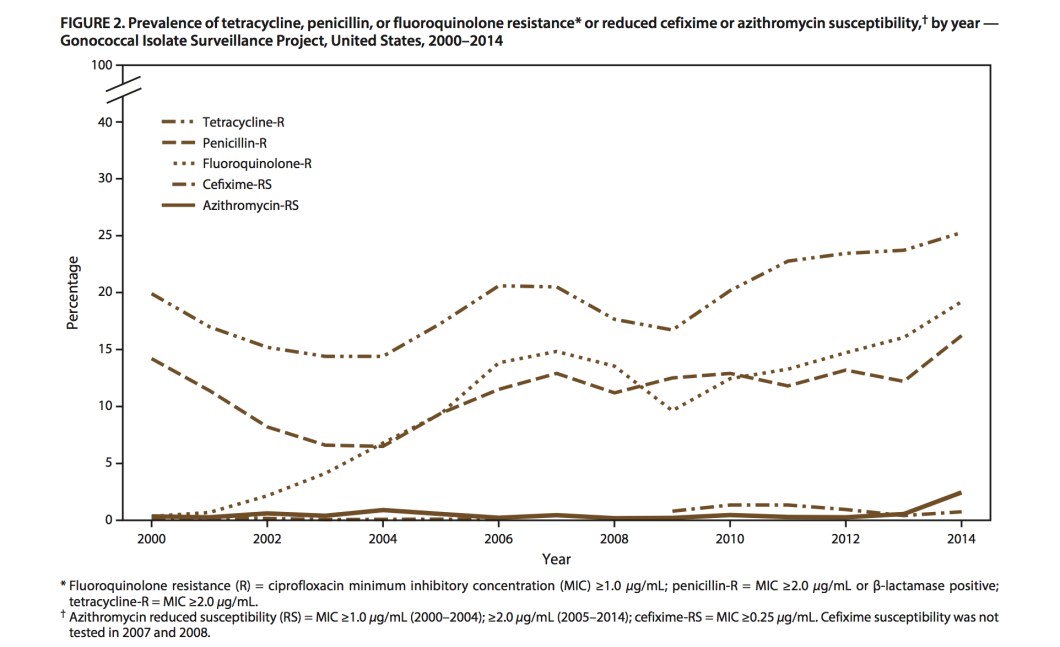Just In Time For The Weekend: CDC Sees Increase In Drug-Resistant Gonorrhea Image courtesy of Barbara Wells
Once upon a time, if you were unfortunate enough to get gonorrhea, it could be treated with penicillin or several other widely used antibiotics. Not only are those drugs largely ineffective in treating the sexually transmitted disease, but a new report from the Centers for Disease Control and Prevention shows a worrisome recent increase in resistance to the drugs that still can be used to treat gonorrhea.
As part of its delightfully titled Morbidity and Mortality Weekly Report, the CDC issued a surveillance summary [PDF] looking at the changes in antibiotic resistance in specimens collected from Americans infected with gonorrhea.
Physicians have long given up on using penicillin and tetracycline to treat the disease because of the high frequency of resistance to those drugs. Starting about 15 years ago, the Gonococcal Isolate Surveillance Project (GISP) — which monitors antibiotic resistance in gonorrhea on a national level — began noticing that fluoroquinolones, an important class of antibiotics that includes ciprofloxacin, were becoming increasingly ineffective.
According to GISP data, between 2000 and 2014, resistance to fluoroquinolones rose from effectively 0% to nearly 20% — higher than the 16% resistance level for penicillin but lower than the 25% rate of resistance for tetracycline.
If 16-25% resistance rates don’t sound alarming to you, think about what that would mean if you’re a patient. The doctor says to you, “Take this antibiotic. It won’t work in 1-in-6 (or 1-in-4) people, but it’s worth a shot.”
These high rates of resistance were what led the shift away from these antibiotics. In 2010, the CDC issued treatment guidelines recommending that gonorrhea be treated with the twin attack of a cephalosporin and azithromycin.
The latest data from GISP suggests that this dual treatment is still overwhelmingly successful in most patients, but raises concerns, especially about the future effectiveness of azithromycin.

In 2013, only .6% of GISP samples demonstrated reduced susceptibility to azithromycin. Within a year, that had increased four times, to 2.4%, turning up most frequently in samples from the Midwest region of the country, where around 5% of cases were less susceptible to the drug.
A trend toward increased resistance to azithromycin “could compromise successful gonorrhea treatment,” writes the CDC. “Not only is azithromycin part of currently recommended dual therapy, it is also a component of each of the alternative treatment regimens for gonorrhea.”
Also of possible concern, notes the report, is a recent decrease in susceptibility to cephalosporins.
In 2010, the CDC issued treatment guidelines recommending the dual treatment of azithromycin and one of two cephalosporins — either the injected ceftriaxone or the oral cefixime. However, almost immediately, samples monitored by GISP showed decreased susceptibility to cefixime. That led the CDC to issue revised guidance in 2012, recommending only ceftriaxone along with azithromycin.
The short-term result in the GISP data was an apparent decrease in resistance to cephalosporins. After peaking in 2011 with 1.4% of samples showing decreased susceptibility to the drug, it had dropped to .4% by 2013. Then suddenly, in just one year that rate has doubled to .8% — still very low, but a figure the CDC is keeping an eye on.
“It is unclear whether these increases mark the beginning of trends, but emergence of cephalosporin and azithromycin resistance would complicate gonorrhea treatment substantially,” concludes the report. “Continued surveillance, appropriate treatment, development of new antibiotics, and prevention of transmission remain the best strategies to reduce gonorrhea incidence and morbidity.”
Want more consumer news? Visit our parent organization, Consumer Reports, for the latest on scams, recalls, and other consumer issues.

